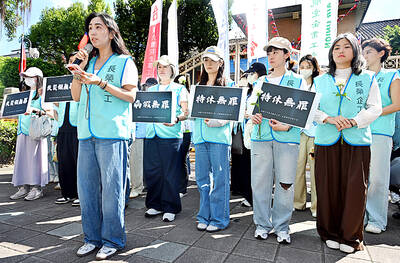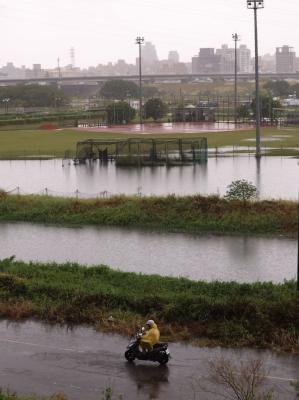The nation’s cable television industry is facing challenges with the advance of the digital television age, a media expert said.
Despite the increasing popularity of over-the-top (OTT) services, the nation has yet to see a significant migration from cable TV to OTT platforms, 21st Century Foundation deputy director Jessica Chou (周韻采) told a Cable and Satellite Broadcasting Association of Asia conference.
Citing National Communications Commission statistics, Chou said the number of cable TV subscribers rose from about 5 million in 2014 to 5.07 million in 2015 and to 5.2 million last year, reversing a slight decline between 2011 and 2013.
One of the main reasons people prefer cable TV is the low subscription fee, she said, which enables subscribers to access a basic cable service with more than 100 channels for only about US$17 per month.
The number of digital cable subscribers also rose from 257,727 in 2009 to 4.98 million last year, Chou said.
There are challenges ahead for cable TV operators, despite the increase in subscribers, she added.
The digital cable service does not attract enough subscribers to premium services, which only account for about 28 percent of digital cable subscribers, Chou said.
The majority of digital cable subscribers continue to use basic cable that costs less than US$20 per month, she said.
The problem is that the nation’s pay-TV industry, including Internet protocol television (IPTV) services, lack the necessary content and services to attract premium subscribers, Chou said, adding that this would hold back growth in cable service revenue.
Netflix shows that a successful service provider must either have mass content or must-have content, Chou said, but added that the business model could be affected by piracy.
Increasingly expensive content authorization fees would encourage more cable or IPTV operators to produce their own content, which would also protect them against piracy, she said.
About two-thirds of OTT service users are between the ages of 18 and 34, whereas a majority of cable TV subscribers are middle-aged or elderly people, Chou said.
The latter group is accustomed to watching basic cable content at fixed times, which explains why there has not been a significant migration to OTT in the short term, she said, adding that the situation explains the lack of subscribers to digital premium services.
However, the challenge for cable TV operators stems from polarized viewing habits, as the industry’s development necessitates a change to how TV channels produce content and how sponsors place advertisements, she said.

The Taoyuan Flight Attendants’ Union yesterday vowed to protest at the EVA Air Marathon on Sunday next week should EVA Airway Corp’s management continue to ignore the union’s petition to change rules on employees’ leave of absence system, after a flight attendant reportedly died after working on a long-haul flight while ill. The case has generated public discussion over whether taking personal or sick leave should affect a worker’s performance review. Several union members yesterday protested at the Legislative Yuan, holding white flowers and placards, while shouting: “Life is priceless; requesting leave is not a crime.” “The union is scheduled to meet with

‘UNITED FRONT’ RHETORIC: China’s TAO also plans to hold weekly, instead of biweekly, news conferences because it wants to control the cross-strait discourse, an expert said China’s plan to expand its single-entry visa-on-arrival service to Taiwanese would be of limited interest to Taiwanese and is a feeble attempt by Chinese administrators to demonstrate that they are doing something, the Mainland Affairs Council said yesterday. China’s Taiwan Affairs Office (TAO) spokesman Chen Binhua (陳斌華) said the program aims to facilitate travel to China for Taiwanese compatriots, regardless of whether they are arriving via direct flights or are entering mainland China through Hong Kong, Macau or other countries, and they would be able to apply for a single-entry visa-on-arrival at all eligible entry points in China. The policy aims

Taipei, New Taipei City, Keelung and Taoyuan would issue a decision at 8pm on whether to cancel work and school tomorrow due to forecasted heavy rain, Keelung Mayor Hsieh Kuo-liang (謝國樑) said today. Hsieh told reporters that absent some pressing reason, the four northern cities would announce the decision jointly at 8pm. Keelung is expected to receive between 300mm and 490mm of rain in the period from 2pm today through 2pm tomorrow, Central Weather Administration data showed. Keelung City Government regulations stipulate that school and work can be canceled if rain totals in mountainous or low-elevation areas are forecast to exceed 350mm in

EVA Airways president Sun Chia-ming (孫嘉明) and other senior executives yesterday bowed in apology over the death of a flight attendant, saying the company has begun improving its health-reporting, review and work coordination mechanisms. “We promise to handle this matter with the utmost responsibility to ensure safer and healthier working conditions for all EVA Air employees,” Sun said. The flight attendant, a woman surnamed Sun (孫), died on Friday last week of undisclosed causes shortly after returning from a work assignment in Milan, Italy, the airline said. Chinese-language media reported that the woman fell ill working on a Taipei-to-Milan flight on Sept. 22